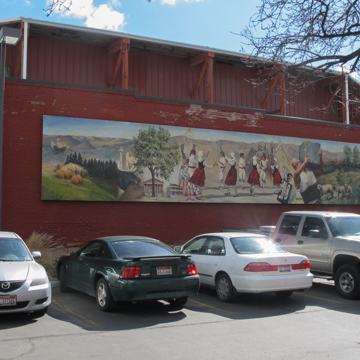You are here
Anduiza Fronton Building
Boise’s Basque community, one of the largest in the United States (some 15,000 according to a 2005 Idaho Statesman article), is celebrated in a small urban area known as the Basque Block. With Basque restaurants and specialty stores, a Basque museum and cultural center, the block also includes one of Boise’s oldest houses and this one-story commercial building that functioned a Basque boarding house for more than thirty years. Throughout the early twentieth century, immigrants from the Basque Country in northeastern Spain and southwestern France arrived in Idaho, Oregon, and Nevada in search of opportunity. Seasonal sheepherding was frequently the only job available, but it was a traditional form of employment in their mountainous homeland. During the off-season, Basque sheepherders moved into town, where boarding houses like this one offered a winter home in Idaho’s capital city.
Basque immigrant Juan “Jack” Anduiza built the one-story boarding house in 1914 and continued to own it until it closed in 1945. Architects Benjamin Nisbet and Frank Paradice, who had recently completed the landmark Empire Building (ID-01-001-0091) nearby, designed the boarding house for Anduiza. Though its size was typical, with accommodations for about forty residents, it was one of the only brick boarding houses in Boise, among the dozen or so that operated downtown in the early part of the twentieth century. The careful but restrained brick corbeling and brick detail suggest that Anduiza felt a particular pride of place about the building, which was the third boarding house he operated.
An important feature of the Anduiza Hotel was its fronton—or Basque handball court. The court is a large room, one-hundred feet long and fifty feet high, where a special ball is played either by hand or with a racket. In 1925, the Idaho Statesman noted the importance of the game to the Basque community: “This game of handball means as much to the Spanish [sic] as baseball and football do to the Americans.” There are frontons throughout the country, but this is the oldest active indoor fronton in the United States. The boarding house era is long over, but the Basque community lives on, as does the fronton. After Anduiza sold the hotel, it was owned by Briggs Engineering, which kept the court in its original condition. The current owner offers space for lease and is protective of the historical nature of the court.
References
Jiulanti, Emily Peeso, “Anduiza Hotel,” Ada County, Idaho. National Register of Historic Places Registration Form, 2003. National Park Service, U.S. Department of the Interior, Washington, DC.
“Jaialdi 2005 kicks off.” Idaho Statesman, July 25, 2005.
Webb, Anna. 150 Boise Icons, to celebrate the city’s sesquicentennial. Boise, ID: Idaho Statesman, 2013.
Writing Credits
If SAH Archipedia has been useful to you, please consider supporting it.
SAH Archipedia tells the story of the United States through its buildings, landscapes, and cities. This freely available resource empowers the public with authoritative knowledge that deepens their understanding and appreciation of the built environment. But the Society of Architectural Historians, which created SAH Archipedia with University of Virginia Press, needs your support to maintain the high-caliber research, writing, photography, cartography, editing, design, and programming that make SAH Archipedia a trusted online resource available to all who value the history of place, heritage tourism, and learning.



























